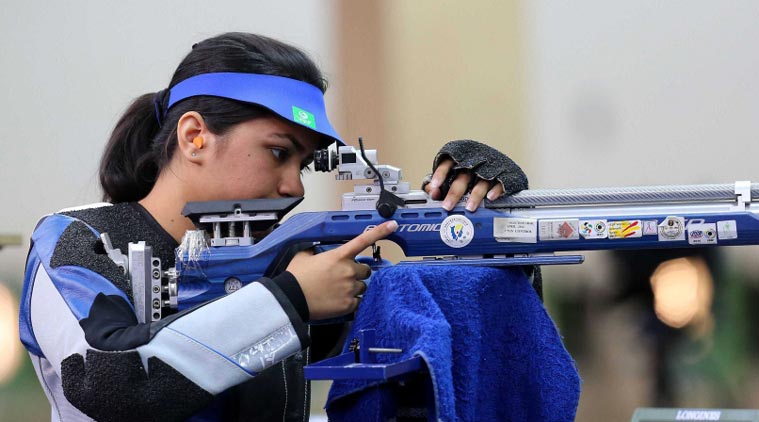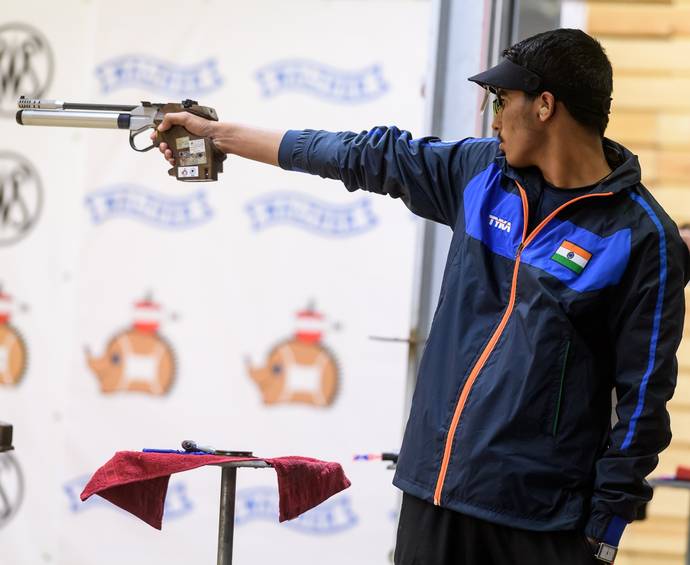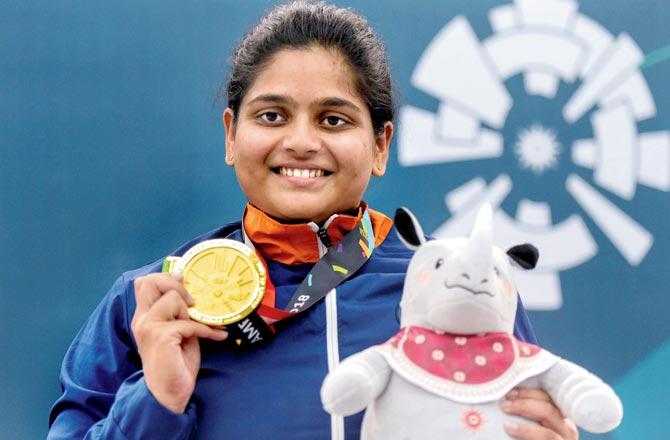Featured
Road to the Olympics: Shooting guidelines for Tokyo 2020 (Part 2)

The part 1 of this article series looked at the various gun types used in Olympic shooting and provided an overview of the 15 events slated to be contested at Tokyo 2020. This article looks at the various events in a little more detail.
Rifle Events
10m Air Rifle (3 events – for men, women, and mixed team)
 Apurvi Chandela
Apurvi Chandela This involves shooting a rifle from a distance of 10 metres. With the rifle being the most accurate gun, and the short distance, this is the only event to use decimal scoring in the qualification as well as the final (all other rifle/pistol events use integer scoring in qualification). Thus, the maximum possible score from a single shot is 10.9, requiring shooting a ring with a diameter of just 0.05 mm!! The 10-ring itself is just a white dot of diameter 0.5 mm.
50m Rifle 3 Positions (2 events – for men and women)
This involves shooting a rifle from a distance of 50 metres, with an equal number of shots fired from 3 different positions – kneeling (which actually involves placing just one knee on the floor as opposed to both knees), prone (i.e., lying on one’s stomach) and standing. All the other events are shot from a standing position. The 10-ring is 10.4 mm in diameter.
Due to the difference in stabilities of the body position, prone always sees the highest scores, followed by kneeling and then by standing. The event is often won or lost in the standing position, which can see wild swings in scores.
Pistol Events
10m Air Pistol (3 events – for men, women, and mixed team)
 Saurabh Chaudhury
Saurabh Chaudhury This involves shooting a pistol from a distance of 10 metres. With the pistol being much less accurate, the target is much bigger than the corresponding rifle event, with the 10-ring being 11.5 mm in diameter.
25m Rapid Fire Pistol (for men only)
The 25 metre pistol events are the only Olympic events which have significant differences for men and women. The men’s event is extremely fast paced with an actual shooting time in qualification totalling to only 72 seconds! However, ironically, it is also an event which is often contested over 2 days.
Shooters shoot a total of 12 series of 5 shots each. In every series, the shooters have to shoot 1 shot each at 5 different targets, in a single shooting motion. In the first two series, this single shooting motion has to be completed within just 8 seconds. The next two series provide 6 seconds each, and the last two provide only 4 seconds each, bringing the first competition day to an end. Then the entire process is repeated on the second day. Every one of the 60 qualification shots can score a maximum of 10 points, on hitting a 100 mm diameter 10-ring.
The final, contested on the 2nd day, consists of only 4-sec series. This leads to a unique situation where shooters strong in 8-sec and 6-sec series but relatively weak in 4-sec series may sneak into the final but can struggle once they get there (a scenario often faced by Rio Olympian Gurpreet Singh). Also, the final follows a unique hit-or-miss format, where every shot of 9.7 or higher is scored as a hit, and others are scored as a miss (effective hit ring of diameter 124 mm).
25m Pistol (for women only)
 Rahi Sarnobat
Rahi Sarnobat This event consists of 2 stages – precision and rapid fire – usually contested over 2 days, followed by the final on the 2nd day.
The precision stage (contested on day 1) involves shooting at a 10-ring of diameter 50mm from a distance of 25 meters. Shooters shoot 6 series of 5 shots each, with each series required to be completed in 5 minutes.
The rapid fire stage (contested on day 2), also known as duelling, also consists of 6 series of 5 shots each. However, every shot has to be taken on command in just 3 seconds, with a 7 second gap between 2 shots of the same series (thus every 5-shot series lasts about 43 seconds). Unlike the men’s rapid fire event, all shots are taken on a single target as opposed to 5 different targets. The 10-ring in this stage has a diameter of 100 mm.
Like the men’s rapid fire event, the final has a hit-or-miss format, with every shot of 10.2 or higher scored as a hit (effective hit ring of diameter 80 mm), and others scored as a miss. Also, the finals consist of only duelling. Thus, significant differences between the results of the qualification and the final can be expected, with shooters strong in the precision stage but relatively weak in rapid fire often struggling in the finals, and vice versa.
Shotgun Events
Shotgun events simulate bird hunting. “Birds”, in the form of clay discs of diameter 110 mm, are released from automatic machines to be shot down. All events are usually held over two days, except for the mixed team event which is completed in one day.
They are contested completely outdoors and, as a result, shotgun scores can depend largely on the conditions, with wind and visibility being major factors. On the other hand, 10m rifle/pistol events are held indoors while 25m and 50m events are usually held semi-outdoors, i.e., the firing points and the targets are under a roof but the majority of the rest of the firing line is open to the elements (though in some circumstances, they may be completely indoors as well).
Trap (3 events – for men, women, and mixed team)
In Trap, shooters shoot from positions directly behind the target releasing machines (themselves also known as traps), which throw the targets forward, away from the shooters.
Only one target is released at a time, but it may be from any of 3 different machines placed 1 to 1.1 metres apart, and at varying angles. In qualification, shooters get 2 shots to shoot down the released target, but in the final and any shoot-offs, shooters need to hit the target with a single shot.
Skeet (2 events – for men and women)
Skeet takes place on a semi-circular field of play. The target releasing machines are placed on the corners of the semi-circle, with the left machine known as the high house (and placed at a higher height) and the right machine known as the low house. Both machines release targets across the diameter of the semi-circle.
Shots are taken from 7 different positions along the edge of semi-circle, and an 8th position at the centre of the semi-circle. Following a fixed known sequence, targets are sometimes released from only one house and sometimes simultaneously from both houses, resulting in a total of 8 pairs and 9 singles forming a 25-shot skeet round, with qualification consisting of 5 such rounds. When shooting pairs, the two targets have to be shot in a defined order.
In the final, only 3 of the 8 shooting positions are used and two targets are always released simultaneously, one from each house. However, despite this fact, the final requires some types of shots to be fired which are never fired in qualification. These special types of shots are known as reverse doubles from firing points 3 and 5, which involve shooting the target farther from the shooter first and the nearer target second.
In shotgun, most shooters stick to either Trap or to Skeet, though there may still be a few who compete in both. On the contrary, many rifle shooters (though definitely not all) compete in 10m as well as 50m events and many pistol shooters compete in both the 10m and 25m events.
Fan Tip: For fans following live shooting scores on the ISSF website, it can sometimes be irritating waiting for the Indian shooters to start shooting their rounds, especially in 25m pistol and shotgun events. This can be avoided by clicking on the “View Start List as PDF” link on the bottom of the live results page. The pdf at this link provides complete starting times for each round for each shooter.
Part 3 of this series will deal with the Olympic qualification process and its intricacies.

